| Strength Workouts |
Speed Workouts ⋅ 10 x 25 |
Stamina Workouts |
Swimmers aren’t the only ones swimming these days. John Clay, running back for the University of Wisconsin, Madison, and 2009 Big Ten Offensive Player of the Year, primarily spends his time in the pool during the off-season. The ING New York City Marathon champion Meb Keflezighi swims year-round for cross-training.
Why the rush for the water? Well, swimming laps burns from 400 to more than 700 calories an hour, builds muscle, and increases aerobic and anaerobic capacity. But it’s what swimming doesn’t do that attracts some of its most dedicated fans.
“As a non-weight-bearing activity, swimming is much less stressful on the body than other forms of exercise,” says Eric Hansen, head coach of men’s and women’s swimming and diving at the University of Wisconsin. “For that reason,” Hansen adds, “I believe swimming should be a part of everyone’s fitness regimen.”
So why doesn’t everyone swim? Some are avoiding what’s known as black-line fever — that feeling of mind-numbing boredom you experience while swimming endless laps in the pool, staring at that black line on the bottom. Others avoid the pool because they simply don’t like swimming, period.
That’s too bad, because there are lots of challenging, enjoyable ways to build fitness in the water that don’t involve simply paddling from end to end. And even if you don’t want to swim at all, you can still burn fat and build strength, speed and stamina in the water.
“Aqua fitness has really expanded recently,” says Carol Argo, a Los Angeles–based aqua fitness instructor who has created a series of aqua fitness DVDs. Today, the options include everything from aqua Pilates to water calisthenics. “There’s something for everyone — young or old, beginner or advanced,” says Argo.
Ready to take the plunge? Turn the page for a selection of smart water workouts (swimming and nonswimming) from aquatic fitness experts who know their way around the pool.
Strength Workouts
Water Calisthenics
Water offers more resistance than air, but the effect of gravity is lessened in the pool. You can take advantage of the viscosity of water and overcome the reduced gravity to get a great strength-building workout by introducing equipment such as a kickboard (which is normally used for kicking drills). The following water-calisthenics workout is adapted from swim coach Steve Tarpinian’s book, The Triathlete’s Guide to Swim Training (VeloPress, 2005):
Push-Pull

- Stand in shoulder-deep water while holding the kickboard against your chest.
- Extend your arms forward, pause briefly, and then pull the board back to your chest. The faster you perform these movements, the more resistance you will experience.
- Continue pushing and pulling for 30 seconds.
Side to Side

- Stand in shoulder-deep water with the kickboard held between your hands and your arms extended straight in front of you.
- Rotate your shoulders to the left as far as you can without rotating your hips.
- Now rotate your shoulders fully to the right.
- Continue rotating your shoulders left and right for 30 seconds.
Leg Curl
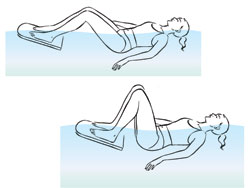
- Float on your back with the kickboard under the heels of both feet.
- Bend both knees and draw the kickboard toward your butt. You may find it helpful to extend your arms to the sides and push downward with your palms to keep your face above water.
- Return to the start position and repeat 10 times.
Ab Roll Out

- Floating face down, begin in a pushup position with the kickboard held between your hands and submerged underwater directly beneath your chest.
- Extend your arms in a slow, controlled movement so the board moves toward the end of the pool you are facing and rises toward the surface in front of you.
- Just before the board reaches the surface, reverse your movement and push the board back underneath your chest.
Additional Calisthenics to Try
Reverse Crunch
- Sit on the kickboard with your hands gripping the edges of the board next to your hips.
- Fully extend your arms beneath you and press the board toward the bottom of the pool.
- Next, straighten your legs and extend them backwards while extending your arms forward so that your feet and the board move toward opposite ends of the pool.
- Finally, contract your abs and draw your knees toward your chest while pulling the board back underneath your butt.
- Repeat 12 to 15 times.
Trunk Twist
- Stand in shoulder-deep water with the kickboard held between your hands and your arms extended straight in front of you.
- Rotate your hips to the right as far as you can without rotating your shoulders.
- Now rotate your hips fully to the left.
- Continue rotating your hips left and right for 30 seconds.
- Keep the kickboard aligned with your sternum as you rotate left and right for 30 seconds.
Leg Extension
- Sit on the kickboard as you would sit on a chair. Begin with your knees bent 90 degrees.
- Quickly and fully extend your right leg forward while remaining in a seated position, then return to the start position and quickly extend the left leg.
- Continue alternating leg extensions for 30 seconds. To make this exercise more challenging, wear flippers on your feet.
Water Pilates
Water Pilates is becoming popular across the country. The following workout is adapted from Argo’s DVD Water Pilates.
Begin with a warm-up by jogging in place in the water for five minutes, focusing on controlling your breath.
After completing your warm-up, proceed through the following sequence of movements:
Hip Abduction/Adduction Plus Arm Swing
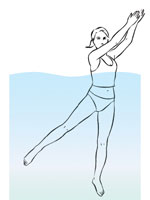
- Stand in waist- to chest-deep water.
- Keeping your right leg straight, slowly extend it out to the side while swinging your arms in the opposite direction, as shown.
- Return to a standing position, shift your weight and then complete the same exercise on the other side.
- Continue alternating right- and left-leg abductions with opposite-direction arm swings for one minute.
Figure 8
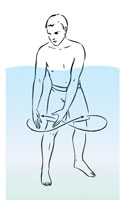
- Stand in waist- to chest-deep water with a slight bend in the knees, arms fully extended and an imaginary soccer ball held between your hands.
- Tilt forward at the hips and push the “ball” down into the water.
- Keeping the “ball” underwater, use your arms to trace a large figure-8 shape with it (as though drawing an 8 pattern on the bottom of the pool). Continue for one minute.
Front-Back Kick
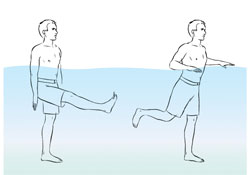
- Stand in waist- to chest-deep water.
- Slowly swing your right leg forward as far as you can without bending your left knee or bending forward at the waist.
- Now swing the same leg slowly backward behind you, again focusing on keeping the rest of your body “quiet.” Flex at your hip joint when your leg swings, keeping your spine neutral. Swing your arms in opposition to your leg movement.
- Continue swinging your right leg forward and back for 30 seconds; then reverse your position and repeat the exercise with your left leg.
Crossing Legs

- Float on your back with your arms wrapped around a noodle at the armpits so the noodle is snug across your upper back. Begin with your ankles together.
- Now separate your feet 18 inches and briskly bring them together again, crossing your left leg over your right at the ankle.
- Spread your feet again and then cross the right leg over the left.
- Continue crossing one leg over the other in alternating fashion with small, quick movements for one minute.
Additional Water Pilates Move to Try
Diamond Pendulum Swing
- Float in a standing “T” position with your arms wrapped around a noodle at the armpits so that the noodle is snug across your upper back.
- Bend your knees sharply, externally rotate your hips, and bring the bottoms of your feet together.
- Maintaining that diamond shape with your legs, swing them to the right as far as you can. Return to the start position and swing your legs to the left.
- Continue swinging your legs in this pendulum-like motion for one minute.
Floating Push-Up
- Float on your belly in the water with your legs fully extended on the surface and your arms extended straight toward the bottom, hands gripping a submerged noodle shoulder-width apart.
- Bend your elbows and allow the noodle to rise toward your chest while pulling your legs down. Press the noodle back down again and bring your legs up to the surface.
- Repeat for one minute.
Fin and Paddle Drills
There are two key tools that competitive swimmers rely on to develop upper-body and leg strength: fins and paddles, both of which create more drag. Pool fins are stubbier than their open-water counterparts, diving fins. “Their purpose is to increase the surface area of the foot and increase water resistance when you kick, which strengthens the legs,” says Tarpinian, creator of the Swim Power DVD series (www.swimpower.com). Swim paddles go on the hands and help build the muscles of the shoulders, upper back and upper arms.
Fins and paddles help build strength and also allow swimmers to focus on improving their kick and arm pull. Here’s a strength-building swim workout using fins and paddles alternately:
Fins
- Warm up by swimming a few laps of easy freestyle without fins or paddles. Next, put fins on your feet and swim.
- 50 yards on your left side with your left arm extended forward and your right arm extended back. Rest 15 seconds.
- 50 yards on your right side with your right arm extended forward and your left arm extended back. Rest 15 seconds.
- 50 yards on your back with your arms resting at your sides. Rest 15 seconds.
- 50 yards normal freestyle.
Paddles
- Now remove the fins, put on the hand paddles, and swim:
- 50 yards taking two strokes with the left arm, then two strokes with the right. Rest 15 seconds.
- 50 yards “catch-up” freestyle (leave your right arm extended in front of you while completing a full stroke with the left arm, then leave your left arm extended in front of you while completing a full stroke with the right arm). Rest 15 seconds.
- 50 yards normal freestyle.
- Remove the paddles and swim a few laps of easy freestyle to cool down.
Speed Workouts
OK, OK, there’s a little lap swimming here. But these workouts are good for spiking your heart rate and improving your speed in the pool. The more efficient your stroke is, the faster you’ll be in the water, and the less tiresome swimming will seem (for more tips on this see “How to Improve Your Swim Stroke“). Good form is key to speed, though, so unless you’re a real pro, you’ll benefit from getting some form pointers before you begin.
10 x 25
The length of the standard indoor lap pool is 25 yards. Thus, 25 yards is the shortest interval you can conveniently swim in such a pool. It’s also the perfect interval length for speed-building swim workouts. According to Tarpinian, swimming fast 25-yard intervals increases swim speed, tones the muscles, boosts anaerobic fitness and burns lots of calories. And, luckily, swimming a set of repeat 25-yard intervals could not be simpler.
- Warm up with a few laps of easy freestyle swimming.
- Then swim 10 x 25 yards as fast as you can, resting as long as you need to between intervals to avoid slowing down. Time each interval and try to improve your splits whenever you repeat the workout.
- As you become fitter, you can also add intervals (up to 20 x 25 yards) to keep the workout challenging.
- Cool down with a few more laps of easy freestyle swimming.
Swim Golf
One of the most important concepts in swimming is distance per stroke — how much distance your body moves forward in the water each time you pull through with your left or right arm. The best swimmers tend to cover the most distance per stroke, because they have powerful arm pulls and streamlined body positions that minimize drag. Swim golf is a workout that San Diego–based triathlon coach Jim Vance likes to use with his clients because it makes a game of trying to improve your distance per stroke.
- To play swim golf, simply swim 50 yards at a moderate pace.
- Time the swim and also count the number of strokes you take with both arms.
- Then add the two numbers together. For example, suppose it takes you 55 seconds to swim 50 yards and you take 42 strokes. That gives you a swim-golf score of 97.
- Now swim seven more 50-yard intervals, resting 20 seconds after each.
- Try to improve your swim-golf score in each interval by swimming a little faster without taking more strokes, by swimming the same speed with fewer strokes, or both.
- Concentrate on increasing your distance per stroke by pulling more powerfully with your arms and getting your body more streamlined in the water. “Changing one small thing can show a big improvement that can be seen objectively,” says Vance.
Stamina Workouts
The stamina you build in the water will translate to dry land, too. Injured runners who rehab in the pool are often surprised at how fit they are when they towel off.
Deep-Water Running
Deep-water running is popular with those who need a break from the roads. You can run in the pool to get the same fat-burning and cardiovascular fitness benefits you get from land running — without the pounding on your legs. Deep-water running doesn’t require any special equipment. All you do is simulate a natural running motion as closely as possible while floating in deep water. You can run in place or move slowly forward with a slight modification of the running motion.
Special flotation belts such as the AquaJogger make it easier to simulate a natural running motion by keeping your body afloat so you can concentrate on moving your legs forward and backward as when running on land.
Deep-water running can be pretty boring if you just maintain a steady, moderate effort for 20 or 30 minutes. Instead, do interval workouts like this one:
- Warm up with five minutes of easy running.
- Run one minute fast.
- Run one minute easy.
- Run two minutes fast.
- Run one minute easy.
- Run three minutes fast.
- Run one minute easy.
- Run two minutes fast.
- Run one minute easy.
- Run one minute fast.
- Cool down with five minutes of easy running.
The Water Polo Leg Burner
Water polo players have a very high level of all-around fitness: strength, speed, endurance — the whole ball of wax. The sport requires that athletes often keep their heads above water without using their hands, which means they have to tread water powerfully with their legs.
They develop this ability by doing workouts like this one, provided by Triathlete Magazine editor and 2004 Olympic Swim Trials qualifier Brad Culp of San Diego, Calif. “It’s a very intense workout that increases leg strength dramatically,” says Culp. “It takes less than 20 minutes to do, but you wouldn’t want it to last any longer!”
Warm up by swimming a gentle breaststroke or modified breaststroke (head out of the water) for five minutes. Next, find a spot at the deep end of the pool and complete the following sequence:
- Two minutes: treading water with hands in the air, elbows at the surface.
- One minute: floating on back.
- One minute: treading water with hands on head.
- One minute: floating on back.
- One minute: treading water with hands in air, elbows at the surface.
- One minute: floating on back.
- 45 seconds: treading water with arms extended overhead.
- One minute, 15 seconds: treading water with arms only.
- Cool down with five minutes of easy breaststroke or modified breaststroke.
Time Trial
Swimming laps doesn’t have to be dull. In fact, it can be quite engaging if you limit the distance, crank up the intensity and pay attention to the clock. Culp suggests that even noncompetitive swimmers perform occasional time trials — solo races against the clock over a set distance — to boost their swim stamina in a motivating way. “Time trials enable you to track your improvement over time, and they motivate you to work hard to keep improving,” he says.
- Start with a very short time trial of 100 yards, done as part of a larger workout.
- Repeat it once a week or so, trying to improve your clocking each time.
- As you gain fitness, increase the distance of your time trial. If you really get into it, says Culp, you can go all the way up to 1,500 meters (1,650 yards) — the classic test of swimming endurance.
Technique Is Everything
Freestyle swimming is not natural. It must be learned, and years of dedicated practice are required to perfect it. But there are some things you can do to climb the learning curve faster. Here’s what Steve Tarpinian, author of The Triathlete’s Guide to Swim Training and creator of the Swim Power DVD series (www.swimpower.com), recommends.
Get a lesson. There’s no substitute for an expert to watch you swim and help you correct form flaws. Note that not every good swimmer has a flair for teaching, though. “Ask people to recommend a good coach at the facility where you swim, or at the store where you buy your goggles,” Tarpinian suggests.
Drill down. There is a lot to think about when you swim freestyle: keeping your elbow high during your arm pull, rotating your hips, keeping your kick tight and more. Technique drills break down the swim stroke into its parts, allowing you to focus on one at a time. “As a beginner, you should devote most of your time in the pool to drills, not actual swimming,” says Tarpinian.
Break it up. Swimming endless laps is not only boring, but it actually slows the process of technique development. “The longer a swimmer of any level swims continuously, the more his or her form breaks down due to fatigue,” says Tarpinian. “Breaking up your swim into very short intervals allows you to keep swimming without fatigue and with better form.”
Learn More
Are you passionate about swimming and aqua fitness? Take your water workouts to the next level by discovering a variety of exciting aquatic exercise ideas here.

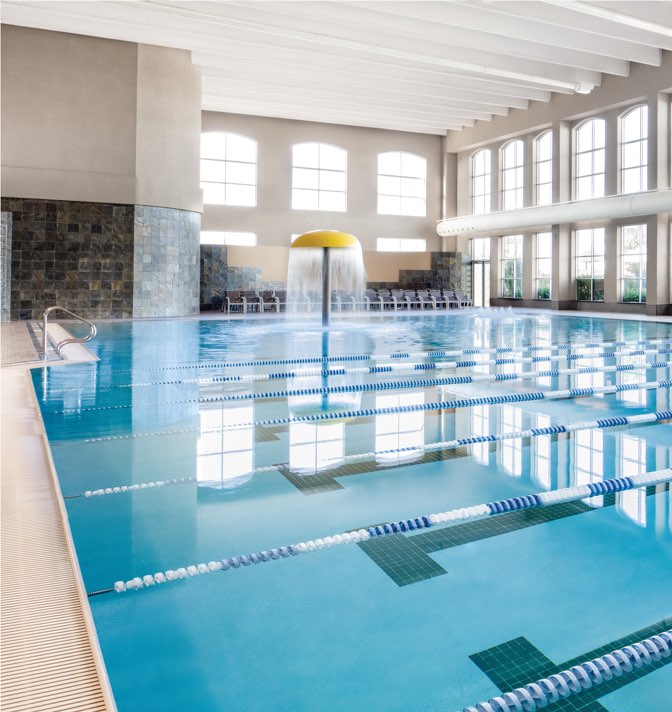
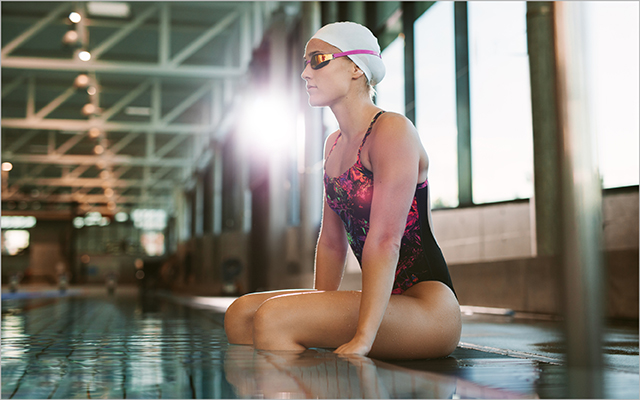
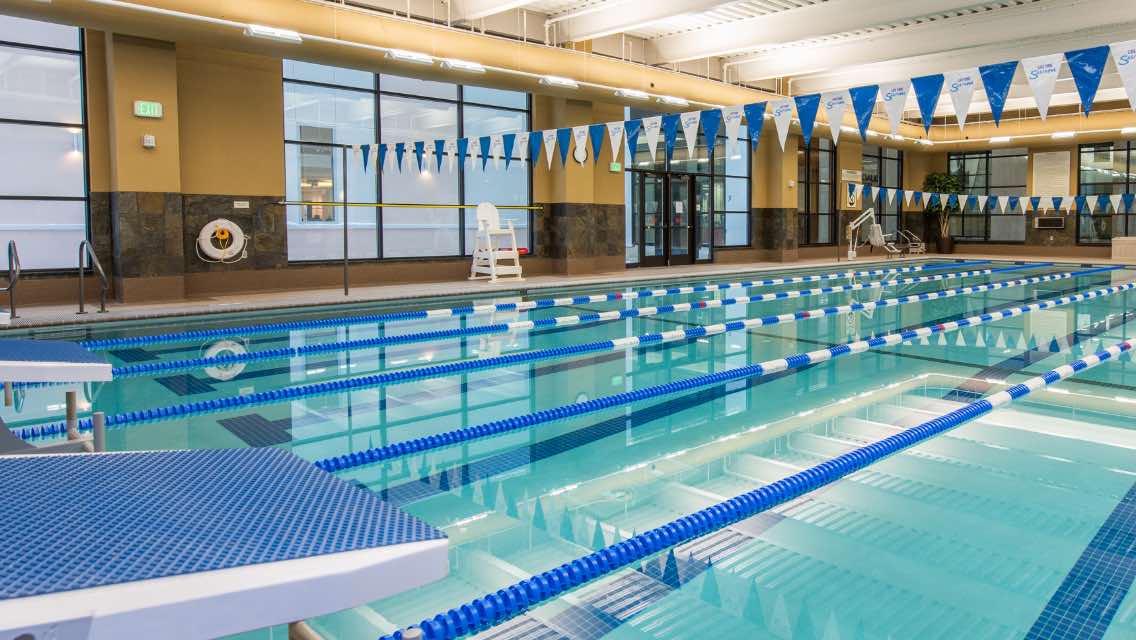

This Post Has 0 Comments